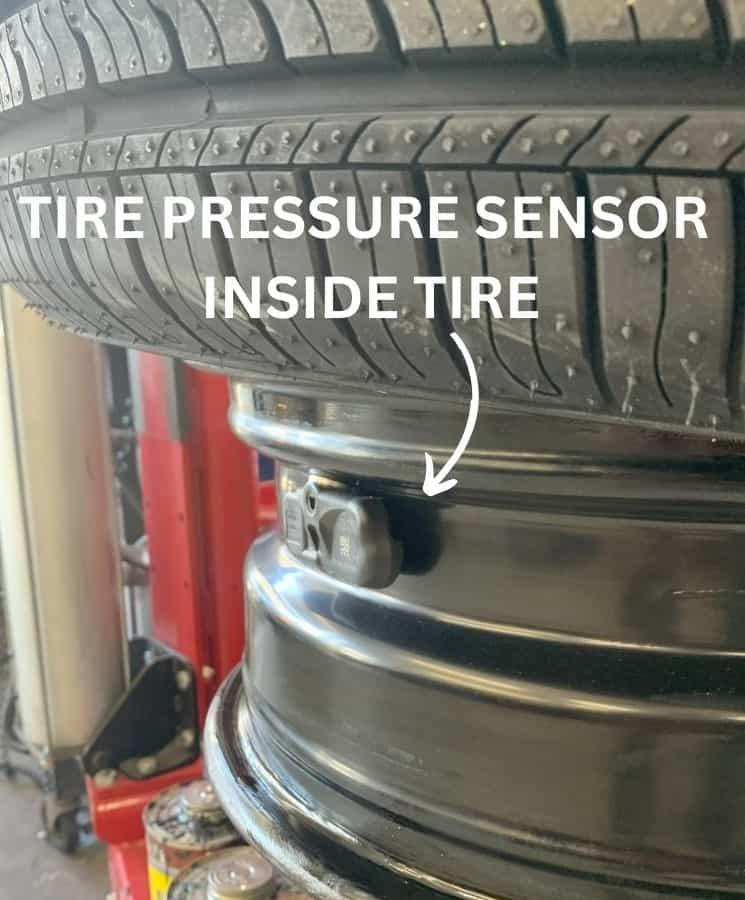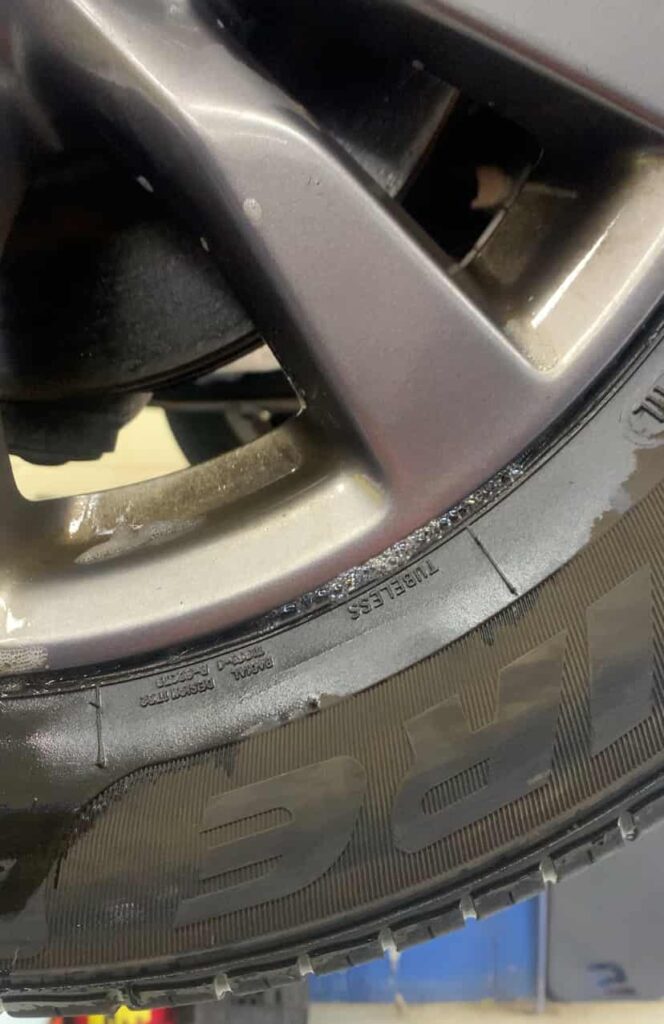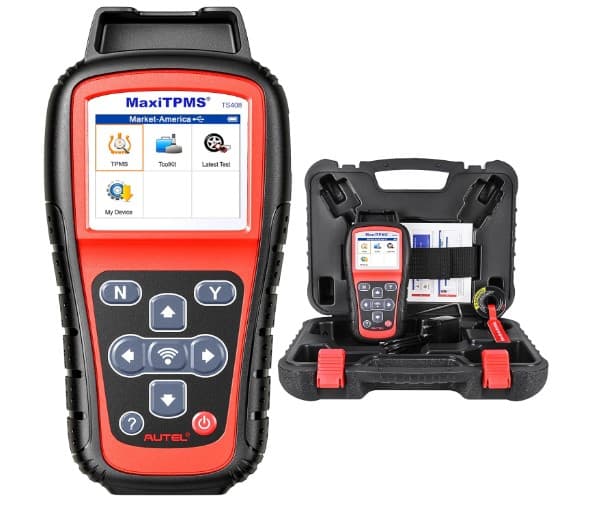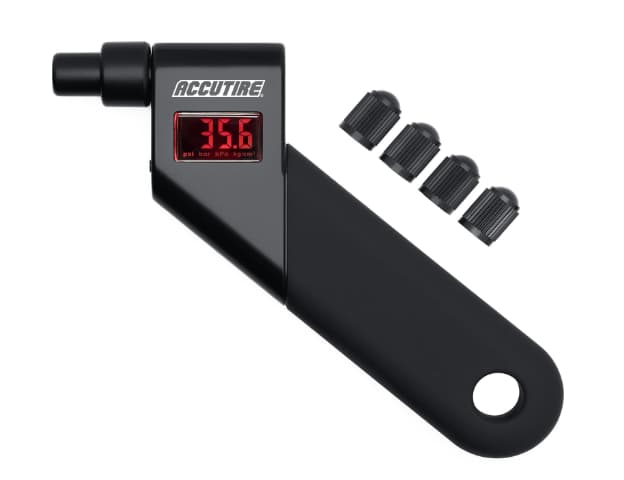What is the Chevy Tahoe TPMS?
The tire pressure system in your Chevrolet Tahoe is an essential yet often underappreciated asset. It consists of the Tahoe’s ECM, a TPMS receiving module, and four distinct pressure sensors in each tire. Together, they showcase the tire pressure data on the Chevy Tahoe’s information screen and notify you if the air pressure is too low.
How Does the Chevy Tahoe TPMS Work?
Sensors:
Located in each Chevy Tahoe wheel.
Hidden inside each tire at the end of the valve stems.
Tracks and measures tire air pressure and tire temperature.
Transmission:
Sensors have built-in transmitters.
Use radio waves to send data to the Tahoe TPMS receiver module.
TPMS Receiver Module:
Collects data from all sensors.
Forwards to the Chevy Tahoe’s main computer (ECM).
ECM (Electronic Control Module):
Analyzes the received tire data.
Compares readings against the Tahoe’s preset values.
Low Tire Alert:
Activated if tire pressure drops below the set threshold.
Displayed on the SUV’s information screen.
TPMS Self-Check:
Monitors the Chevy Tahoe tire pressure monitoring system’s own functionality.
Alerts driver with flashing light if malfunction detected.
Steps to Reset the Chevy Tahoe Tire Light
🔎 The Chevrolet Tahoe does not have a TPMS reset button.
Wait 3 hours after last driving for the tires to be in a cold state.
Set the air pressure of all four tires of the Chevy Tahoe according to the information on the driver side door’s tire sticker.
Drive the Chevy Tahoe at speeds above 25 Mph for a short duration.
Steps to Relearn the Chevy Tahoe Tire Pressure Sensors
When the Chevy Tahoe undergoes tire services or sensor changes, apply the following tire pressure sensor relearn routine. This confirms the ECM’s awareness of each tire’s current location.
Pump all tires to approximately 40 Psi.
Turn the Chevy Tahoe Ignition ON while leaving the engine Off.
Select the Menu Tab on the information display.
Choose “Vehicle Information.”
Choose the “Tire Pressure Menu.”
Hold the SET/CLR button.
The Chevy Tahoe information display screen will show the following message “Are you sure you want to relearn?”
Affirm with “Yes.”
Two horn beeps confirm and “TIRE LEARNING ACTIVE” will be seen on the screen.
Go to the left front tire (driver side front tire), and deflate the air pressure until you hear the horn beep.
Sequentially, do the same for front right, rear right, and rear left tires.
The on-screen “tire learning active” message vanishes upon successful completion.
Deactivate the ignition and readjust all tire pressures back to the Chevy Tahoe’s recommended levels.
NOTE: Only follow the Chevy Tahoe tire pressure sensor relearn process in order above. (LF, RF, RR, RL)
2023 Chevy Tahoe Tire Pressure
TIRE SIZE | FRONT PSI | REAR PSI |
265/65R18 | 35 | 35 |
275/60R20 | 35 | 35 |
275/50R22 | 35 | 35 |
What Activates the Low Tire Light in the Chevy Tahoe?
Improper tire air levels (low or high)
Air leak in tire
TPMS sensors not in tires
Fading or non-functional TPMS sensor batteries
Problems with TPMS receiver module or Chevy Tahoe’s ECM (main computer)
Electromagnetic disruptions from nearby vehicles or electronics
Change in air temperature
Driving the vehicle over its weight/load capacity
Use of tire chains
Thick window tints
Road temperature changes
Tire issues like holes, tire dry-rot, or tire sidewall bubbles
Inconsistent tire sizes on truck
Wheels out of alignment
TPMS sensors damaged during tire setup
Neglecting TPMS reset or TPMS sensor relearn following tire services or rotations
Tire valve stem or valve stem core leaks
Chevy Tahoe Tire Pressure Sensor Batteries
The Chevy Tahoe’s tire pressure sensors are equipped with a small silver oxide battery in each wheel. The expected duration of these batteries ranges from 5-10 years or spans 100,000-150,000 miles. These batteries are responsible for energizing the sensor’s circuit board and transmitter. Given that the TPMS sensor batteries are non-rechargeable and non-replaceable, a drained or dead battery means the whole sensor needs swapping with a new one.
6 Tips to Resolve the Chevy Tahoe Tire Light Alerts
The tire pressure indicator in the Chevy Tahoe has been a source of annoyance for numerous drivers. Here’s a set of guidelines to diagnose the cause of the illuminated tire light and strategies to extinguish it when the common TPMS reset and relearn doesn’t do the trick.
TIP 1: DIAGNOSING A GRADUAL TIRE DELFATION IN THE CHEVY TAHOE
Should the tire light be active, and you’ve adjusted the tire pressures to the specified 35 Psi, and then the light deactivates, it’s a confirmation that the Chevy Tahoe’s tire monitoring mechanism is in working condition. On the other hand, if the tire light reignites after turning off, it’s probable that a tire is gradually deflating. Inspect the pressures of all the tires with a hand-held air gauge to pinpoint the affected one.
TIP 2: FINDING THE LEAK ON A DEFLATING TIRE
To locate the specific leakage point on the tire you’ve identified as deflating, go through the following process.
Materials Needed: Air pump, spray bottle, water, liquid soap or detergent.
Steps:
Using the air pump, inflate the deflating tire to around 35-40 Psi.
Fill the spray bottle with a mixture of water and soap. (Alternatively, you can use a solution like Windex.)
Drench the tire thoroughly with your mixture.
Keep an eye out for any bubbling on the tire’s surface.
Trace these bubbles back to their starting point.
🔍Tip: If the leakage is on the tire’s tread, consider patching or plugging. For leaks on the bead seal, the tire should be bead sealed. Valve stem leaks call for a valve stem replacement.
TIP 3: USING THE AUTEL TPMS PROGRAMMING TOOL FOR DIAGNOSTICS
If you’re thinking that the illuminated tire pressure light on your Chevy Tahoe stems from a defective TPMS sensor, utilizing a TPMS programming/relearn tool can provide clarity. At my automotive shop, I frequently use the Autel TPMS programming instruments for diagnosing any issues related to tire pressure sensors. You simply link the TPMS device to the Chevy Tahoe through its OBD2 port. Once connected, it scans and offers a comprehensive analysis, presenting details like sensor battery health, current tire temperature, and the signal quality of the tire pressure sensor.
🔍Tip: Be alert for signs in the report like a dwindling battery, unlikely temperature figures such as -171 degrees, or disrupted signal transmission – these are indications the sensor might need a replacement.
TIP 4: DISCONNECTING THE CHEVY TAHOE 12 VOLT BATTERY TO RESET THE TPMS
Each time a low tire pressure warning is triggered, the engine control module of the Chevy Tahoe logs it in memory. To reset this memory, you need to disconnect it from its energy source: the 12-volt battery.
Begin by detaching the negative terminal end of the battery.
Pause briefly before reattaching and securing the battery terminal.
Then, drive the Chevy Tahoe at a steady pace of 50 Mph for half an hour.
🔍Note: If post-procedure, the tire light extinguishes but then reignites during your drive, this could indicate a dwindling battery in the tire pressure sensor or a tire that’s deflating.
TIP 5: REVISITING THE CHEVY TAHOE TPMS RELEARN PROCESS
In case the TPMS relearn approach for the Chevy Tahoe doesn’t turn off the low tire alert, give this a shot:
Let out around 15 Psi from the tire in question.
With the aid of a tire inflator, boost the tire’s pressure to 40 Psi, exceeding the Tahoe standard 35 Psi by 5 psi.
Take the Chevy Tahoe for a short spin while the tire is overpressured.
Afterward, adhere to the previously described Chevy Tahoe TPMS relearn instructions.
TIP 6: UNDERSTANDING PSI FLUCTUATIONS WITH AMBIENT TEMPERATURE CHANGES
The Chevy Tahoe’s tire pressure is significantly influenced by both tire and ambient air temperatures. It’s widely recognized that for every 10-12°F shift in temperature, tire air pressure alters by about 1 Psi. Consider this scenario: You leave your Chevy Tahoe parked overnight in an ambient temperature of 81°F. Come morning, the temperature drops to 42°F, and you notice the low tire pressure indicator lit. This light is due to the 40°F dip causing a drop of roughly 4 psi in the tires (at least!). Conversely, as temperatures climb due to weather and driving, the tire pressure also rises. Thus, the Chevy Tahoe’s tire pressure indicator might illuminate and then extinguish solely based on weather conditions and driving.
🔍For the most precise readings, it’s advisable to let your tires cool down (typically around 3 hours post-driving) before adjusting or measuring their pressure. This ensures the tires are in the “recommended cold” state and prevents over inflating or under inflating the Tahoe’s tires.
Important Chevy Tahoe Questions and Information
WHAT IS A SAFE TIRE PRESSURE IN THE CHEVY TAHOE?
The safe tire pressure in the Chevrolet Tahoe is the recommended cold pressure of 35 Psi.
THE LINK BETWEEN CHEVY TAHOE'S FUEL EFFICIENCY AND TIRE PRESSURE
Fuel efficiency in the Chevy Tahoe is intricately tied to its tire pressure. A tire that’s optimally inflated minimizes rolling resistance, ensuring a smoother ride and more miles per gallon. Research indicates that the Chevy Tahoe could see a 0.2% reduction in gas mileage for each PSI that the tire pressure falls below the recommended level. In the long run, this seemingly small percentage can culminate in significant extra fuel costs as well as a negative impact on the environment.
WHAT ARE THE OPTIONS FOR TIRE PRESSURE SENSORS WHEN CHANGING WHEELS OR TIRES?
Upon replacing the tires of your Chevy Tahoe, it’s essential to carry out the standard TPMS reset and tire pressure sensor relearn sequence. If you decide to replace the wheels or rims, you can opt to relocate the old tire pressure sensors to the new set or buy a new set of sensors. Ensure they’re properly programmed to the Chevy Tahoe’s ECM using a TPMS programming tool.
SAFE DRIVING RECOMMENDATIONS FOR CHEVY TAHOE OWNERS
We suggest refraining from driving if the tire pressure warning light is active. Assess the Chevy Tahoe’s tire pressures using a manual air pressure gauge to understand the reason for the alert. With this information, you can evaluate whether it’s safe to proceed on your journey.
THE IMPORTANCE OF IMMEDIATE ACTION WITH TIRE LEAKS
If the tire light in your Chevy Tahoe is on, the cause of its activation should dictate how much further you drive. Should there be a tire leak, cease driving and rectify the situation ASAP.
WHY IS THE CHEVY TAHOE TIRE LIGHT FLASHING?
A blinking tire light in your Chevy Tahoe signifies a potential communication problem between one or more tire pressure sensors and the TPMS receiver module or ECM. This might be because of a depleted battery in a TPMS sensor or using the spare tire which doesn’t have a sensor. Such an occurrence is termed a TPMS malfunction.
GUIDELINES FOR REPAIR VS. REPLACEMENT OF TIRES
Tire plugs are our go-to solution for repairing tire punctures at our auto shop. When dealing with larger punctures, we advise using tire patches. But, if there’s a puncture on the sidewall or if the tire tread has diminished greatly, it’s time to replace the tire.
TIRE SEALANTS ADVERSE EFFECTS ON TIRE PRESSURE SENSORS
When you apply tire sealants like fix-a-flat or slime for a provisional tire repair, you’re introducing a liquid into the tire. Given that the tire houses electronic sensors, there’s a possibility that the sealant might affect the tire pressure sensor adversely. Always test your Chevy Tahoe tire pressure sensors for any damage post-sealant use.
Everything in this article is applicable to all Chevrolet Tahoe models and trims including the Chevy Tahoe LS, LT, RST, Z71, Premier, and High Country.
Please note that this blog post contains Amazon affiliate links. This means that if you make a purchase through one of these links, we at TPMSRESET.COM may earn a small commission at no extra cost to you. We only recommend products that we personally use and believe in. Thank you for supporting us.










